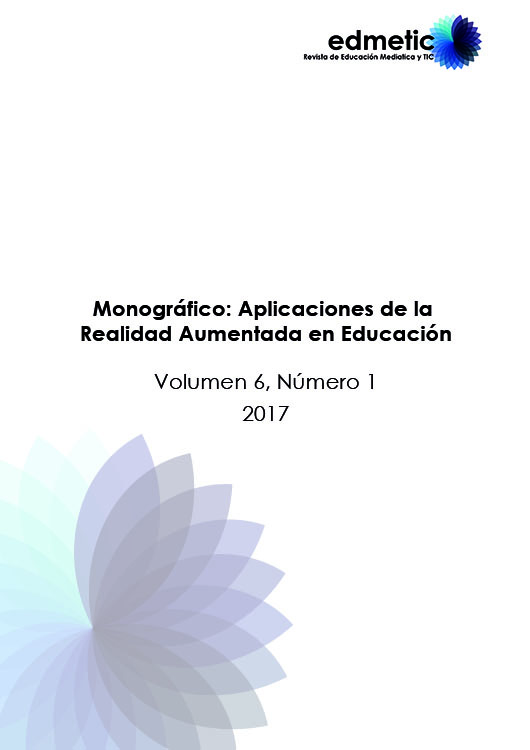Realidad aumentada, proyectos en el aula de primaria: experiencias y casos en Ciencias Sociales
Main Article Content
Abstract
Downloads
Article Details
TRANSFER RIGHTS AND COMMITMENTS TO EDMETIC, REVISTA DE EDUCACIÓN MEDIÁTICA Y TIC
E-ISSN: 2254-0059
The undersigned author(s) of article entitled:
- Transfer to EDMETIC, Revista de Educación Mediática y TIC publishing rights of the article mention before. The magazine will have the right to publish in any format or media this article.
- The author(s) claim that this article is original and which has not been published before in any format and wasn´t submitted for evaluation to another publication.
- The author(s) claim that this article has the copyright´s permissions for publication
- The author(s) accept the changes to the contents on the review, and changes in the style of the manuscript by the Editorial Board of EDMETIC, Revista Educación Mediática y TIC.
- The author(s) declare that they have complied with the ethical principles of research.
- The author(s) not be subject to personal or business association that involves a conflict of interest with article presented
- El author(s) undertakes to give the primary sources of information, if requested.
Date:
Author(s) names and signatures (1):
(1) Fill the form and send to: revistaedmetic@uco.es
References
ADAMS BECKER, S., FREEMAN, A., GIESINGER HALL, C., CUMMINS, M., y YUHNKE, B. (2016). NMC/CoSN Horizon Report: 2016 K-12 Edition. Austin, Texas: The New Media Consortium. Recuperado de http://cdn.nmc.org/media/2016-nmc-cosn-horizon-report-k12-EN.pdf
AUSUBEL, D.P., NOVAK, J.D., y HANESIAN, H. (1983). Psicología Educativa. Un punto de vista cognitivo. México: Trillas.
AZUMA, R. (1997): A Survey of Augmented Reality. Teleoperators and Virtual Environments 6(4), 355-385.
BACCA, J., BALDIRIS, S., FABREGAT, R., GRAF, S., y KINSHUK (2014). Augmented reality trends in education: a systematic review of research and applications. Educational Technology & Society, 17(4), 133-149.
BASOGAIN, X., OLABE, M., ESPINOSA, K., ROUECHE, C., y OLABE, J.C. (2007). Realidad Aumentada en la Educación: una tecnología emergente. Recuperado de http://goo.gl/wl9AWu.
CABERO, J., y BARROSO, J. (2016a). The educational possibilities of Augmented Reality. NAER, Journal of New Approaches in Educational Research, 5(1), 44-50. doi:10.7821/naer.2016.1.140.
CABERO, J., y BARROSO, J. (2016b). Ecosistema de aprendizaje con “realidad aumentada”: posibilidades educativas. Tecnología, Ciencia y Educación, 5, 141-154.
CABERO, J., y GARCÍA, F. (coords.) (2016). Realidad aumentada: tecnología para la formación, Madrid: Síntesis.
CABERO, J., GARCÍA, F., y BARROSO, J. (2016). La producción de objetos de aprendizaje en “Realidad Aumentada”: la experiencia SAV de la Universidad de Sevilla. International Journal of Educational Research and Innovation, 6, 110-123.
CARRACEDO, J., y MARTÍNEZ, C.L. (2012). Realidad Aumentada: Una alternativa metodológica en la Educación Primaria Nicaragüense. IEEE-RITA, 7(2), 102-108.
CÓZAR, R., DE MOYA, M.V., HERNÁNDEZ, J.A., y HERNÁNDEZ, J.R. (2015). Tecnologías emergentes para la enseñanza de las Ciencias Sociales. Una experiencia con el uso de Realidad Aumentada en la formación inicial de maestros. Digital Education Review, 27, 138-153.
ESTEBANELL, M., FERRÉS, J., CORNELLÁ, P., y CODINA, D. (2012). Realidad Aumentada y códigos QR en Educación, en Tendencias emergentes en Educación con TIC. Barcelona: Espiral.
EUROPEAN PARLIAMENT AND COUNCIL (2006). Key Competences for Lifelong Learning-A European Framework. Official Journal of the European Union on 30 December 2006/L394. Recuperado de http://eur-lex.europa.eu/LexUriServ/site/en/oj/2006/l_394 /l_39420061230en00100018.pdf
JOHNSON, D. W. (2003). Social interdependence: interrelationships among theory, research, and practice. American Psychologist, 58(11), 934-945
JOHNSON, G. (2006). Synchronous and asynchronous text-based CMC in educational contexts: a review of recent research. TechTrends: Linking Research and Practice to Improve Learning, 50(4), 46-53.
JOHNSON, L., ADAMS BECKER, S., CUMMINS, M., ESTRADA, V., FREEMAN, A., y HALL, C. (2016). NMC Horizon Report: 2016 Higher Education Edition. Austin, Texas: The New Media Consortium. Recuperado de http://cdn.nmc.org/media/2016-nmc-horizon-report-he-EN.pdf
KOEHLER, J., y MISHRA, P. (2008). Introducing Technological Pedagogical Knowledge. En AACTE (Eds.). The Handbook of Technological Pedagogical Content Knowledge for Educators. Routledge/Taylor & Francis Group/American Association of Colleges of Teacher Education.
MILGRAM, P. Y KISHINO, F. (1994): A Taxonomy of Mixed Reality Visual Displays, IEICE Transactions on Information and Systems, E77-D (12), 1321-1329.
MISHRA, P., y KOEHLER, J. (2006). Technological Pedagogical Content Knowledge. A new framework for teacher knowledge. Teachers College Record, 108(6), 1017-1054.
MULLEN, T. (2012). Realidad Aumentada. Crea tus propias aplicaciones. Madrid: Anaya.
SÁEZ-LÓPEZ, J. M., MILLER, J., VÁZQUEZ-CANO, E., y DOMÍNGUEZ-GARRIDO, M. C. (2015). Exploring Application, Attitudes and Integration of Video Games: MinecraftEdu in Middle School. Educational Technology & Society, 18(3), 114–128. Recuperado de http://www.ifets.info/journals/18_3/9.pdf
SÁEZ-LÓPEZ, J.M., ROMÁN-GONZÁLEZ, M., y VÁZQUEZ-CANO, E. (2016). Visual programming languages integrated across the curriculum in elementary school. A two year case study using scratch in five schools. Computers & Education, 97, 129-141. doi:10.1016/j.compedu.2016.03.003
SÁEZ LÓPEZ, J. M., y RUIZ- GALLARDO, J. R. (2013). Enseñanza de las ciencias, tecnología educativa y escuela rural: un estudio de casos. Revista Electrónica de Enseñanza de las Ciencias, 12(1), 45-61. Recuperado de http://reec.uvigo.es/volumenes/volumen12/reec_12_1_3_ex666.pdf
SANZ DE ACEDO LIZARRAGA, M. L. (2010). Competencias Cognitivas en Educación Superior. Madrid: Narcea.
